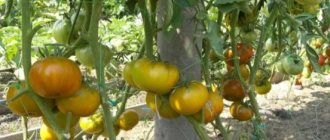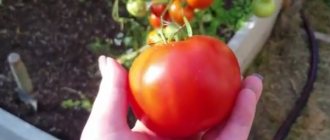| Ripening period: | average |
| Shape, weight of fruits: | flat-round, up to 400 g |
| Bush type: | semi-determinate |
| Growing regions: | everywhere |
| Productivity: | up to 3 kg per plant |
Many people believe that the best salad tomatoes are pink or raspberry. They are more tender and sweeter than red ones, but the taste and aroma are not as “flat” as white or yellow ones. The fruits of such tomatoes accumulate the most carbohydrates and are champions in fiber and potassium content. The Pink Elephant tomato is a worthy representative of pink-fruited varieties; it grows in film and permanent greenhouses; in the south it bears fruit well in open ground.
Description of fruits and characteristics of the Pink Elephant variety
Pink elephant tomatoes have been included in the State Register of the Russian Federation since 1998 with a recommendation for cultivation in all regions of the country, in the coldest zones - under temporary shelter. Not suitable for industrial cultivation, this crop has gained popularity among amateur gardeners.
Tomato "Pink Elephant"
Description of the bush
The semi-determinate tomato Pink Elephant has a medium-sized bush with massive, spreading branches, and therefore requires a garter. Due to high yields, clusters with large fruits require additional support.
The height of the bush is from 1.2 to 1.5 m (depending on the frequency of pruning).
The plant is also characterized by active foliage growth and requires frequent pinching. The leaves of the tomato are large, wide, and rich green in color.
Fruit characteristics
The fruits of the Pink Elephant tomato variety have a round, somewhat flattened shape. The slightly concave stalk has faint ribbing and a small green spot that fades as it ripens. The skin color of ripening tomatoes ranges from pale pink to deep crimson (for ripe ones). Tomatoes are distinguished by honey-sweet fleshy pulp without sourness. The weight of one tomato is from 300 to 1000 g.
Fruiting and productivity
Pink elephant belongs to the high-yielding varieties. The crop is valued for its abundant fruiting and massive fruits with excellent taste. According to the description of the Pink Elephant tomato variety, photos and reviews from agronomists, the average yield of one bush is up to 4 kg per season.
Due to the impressive dimensions of the plant, the harvest volume from 1 m2 is up to 8-9 kg.
Attention: there is an Elephant in the arena!
The arena will be beds or a greenhouse, since this semi-determinate type tomato grows well in the open air and in shelters. The tomato is mid-season, the harvest begins in 110-115 days. The vigorous bushes of the Pink Elephant are densely covered with leaves. The leaf blades are dark green, potato-shaped.
Inflorescences appear after the 7th leaf, then go through two leaves. Each cluster contains 3-4 fruits.
Despite the fact that the plant is powerful, it requires staking to supports. The best way to grow tomatoes is on a trellis, when the tomatoes are carefully attached to wire or ropes, thereby avoiding thickening of the plantings and breaking branches and bushes.
The tomato got its name for a reason; its fruits surprise with their large size and fleshy pulp. Their shape is round, slightly flat, always with ribbing near the stalk. Weight – 280-300 grams, with special care (keeping in one trunk, formation of inflorescences) they reach 400-500 grams.
The use is universal, although the whole Pink Elephant fruit is not suitable for canning and pickling due to its size. But everyone likes tomatoes when sliced, as well as a component for any winter preparations. Juice, paste, sauces are obtained from the fruits, lecho and soup dressings are prepared. But it is best to eat this beautiful and tasty tomato fresh or in a summer salad, when all the vitamins are fully preserved in the fruit.
Planting dates and care of Pink Elephant tomatoes
The time to plant seeds in the soil is the 2nd ten days of March. Mandatory disinfection must be carried out first. To do this, place the planting material for seedlings in a solution of potassium permanganate for 20-30 minutes.
Planting dates and care of Pink Elephant tomatoes
Sowing is carried out from mid to late March. If you plant seeds in the ground earlier, they may not sprout (especially in the northern regions). Climatic conditions also play an important role: if the air temperature has stabilized and the weather is mostly sunny outside, you can start working. However, if the air has not warmed up completely, it is better to postpone sowing until early April.
Growing seedlings
In reviews of Pink Elephant tomatoes, gardeners recommend any deep, disinfected containers with drainage holes for growing future seedlings. Prepare planting soil manually by mixing garden soil and humus, sand and ash, mixed in equal quantities. Then heat the mixture in an oven at 70 °C for additional disinfection.
Move the seedlings to the greenhouse towards the end of April, under film cover in the second ten days of May, and into open ground at the beginning of June.
Due to their size, bushes are planted according to the scheme 1-2 per 1 m2. Bury the seedlings in well-moistened soil to the level of the first leaves. After replanting, water the soil and mulch.
Care after transplant
After moving into the ground, tomatoes need regular watering with heated water, weeding and loosening of the soil. Plants should be fed every 2 weeks, alternating mineral mixtures with organic ones. When the first ovaries appear on the seedlings, switch to potassium-phosphorus fertilizing.
Formation and rationing
One of the most important conditions for obtaining a rich and tasty Pink Elephant harvest is the correct formation of the bushes. Without pinching, the fruits may grow small and lose their special taste.
Formation of a tomato bush
The formation of tomatoes begins after the formation of the first flower cluster. To achieve maximum yield, agronomists advise growing the crop in two stems. In addition, tomato flower clusters are also formed, leaving 2-4 buds in each. It is important to consider that an excess of ovaries in the lower part can lead to depletion of the bush, stopping growth and flowering.
Transplanting seedlings
Two months should pass from emergence to planting.
The plants are replanted at the end of May, after 60 days from the emergence of seedlings. The soil is prepared in advance by adding humus. When landing, follow these rules:
- put a little compost in the prepared holes, located at a distance of 60-70 cm from each other;
- place the plants in the depressions and water them abundantly;
- Cover the roots with soil and mulch.
To carry out this procedure, choose a cloudy warm day or evening.
Diseases and pests of the variety
The Pink Elephant tomato has average resistance to diseases characteristic of nightshades. Without quality care and regular prevention, it will be difficult for the plant to resist infections on its own. To obtain a rich and healthy harvest, it is necessary to carefully monitor the condition of the bushes (especially after transplanting to a permanent place) and treat the seedlings with recommended preparations.
Preventive measures
The pink elephant is prone to diseases:
- Brown rot. Appears due to an excess of nitrogen in the soil, as well as after heavy soil moisture. Affected plants must be burned, the remaining bushes must be sprayed with fungicides: Bordeaux mixture, Zaslon or Fundazol.
- Mosaic. To prevent disease at the harvesting stage, treat the seeds in a Fitosporin solution. If the infection has affected adult bushes, they must be torn out and burned. Treat the soil with manganese solution and sprinkle with wood ash. For subsequent prevention, spray healthy plants with a 5% urea solution.
Bacterial mottling may also be encountered when growing Pink Elephant. Remove infected branches and spray healthy plants with copper sulfate solution. For further prevention, you can use Bordeaux mixture or Fitosporin solution.
Pest and disease control
Sometimes the Pink Elephant tomato is attacked by insects - thrips, whiteflies and spider mites. To protect the plant, use insecticides, concentrated decoctions of onion peels, chamomile or celandine.
If aphids are infested, treat tomatoes with warm soapy water. To repel pests, plant several bushes of mint, celery or parsley at the base of the plants.
About growing tomatoes
Tomatoes of this variety are included in the State Register and are included in the top twenty best tomatoes in the country every year. To achieve good results, it is necessary to comply with certain requirements, starting from the very first stage.
Features of planting seedlings
Seeds are sown 2 months before placement in the ground. Gardeners usually plan the second half of March for sowing. Before this, prepare special containers:
- containers with lids;
- deep containers with a tray, the ability to make drainage holes.
Seeds are usually specially treated before sowing. They are soaked for 10 hours.
Information! For soaking, use a saline solution or a growth stimulator.
For sowing, take a mixture of garden soil and humus; it is recommended to add river sand or wood ash.
- The soil is placed in containers.
- Seeds are planted 2 centimeters deep.
- Plantings are sprayed with water.
- Cover with film to create a greenhouse effect.
- The film is removed after germination.
- For good growth and development of seedlings, provide access to light and regular watering with warm water.
See also
Description of the President tomato variety, features of cultivation and care
Read
Lighting for seedlings
If there is a lack of light, tomatoes should be provided with additional sources. Daylight lamps are suitable for this; the method requires maintaining a balance between light and watering.
Picking
Seedlings of the variety need to be pinched after the first leaves appear. They are removed, and the sprouts are planted in separate containers.
Hardening of seedlings
This technique is used to grow seedlings that are strong and resistant to temperature changes. The seedlings are under the film for the first 5 days. After this, the film is removed, the temperature above the soil drops to +15-16 degrees. Then it gradually levels out with room temperature.
Landing in the ground
Planting on open areas of land is carried out only when the soil is sufficiently warmed up. To facilitate this process, a week before the intended procedure, the ground is dug up and then covered with film material. Greenhouse conditions require simple digging of the soil.
A layer of ash is placed in the hole, then the sprout is dug in, compacted, and spilled with water. To ensure conditions around the planted plant, a trench is dug. This allows the soil to retain moisture and makes further watering easier.
A certain landing pattern has been adopted for the Pink Elephant:
- open ground - early June;
- greenhouse conditions – second half of May.
Advantages and disadvantages of Pink Elephant tomatoes
The advantages of Pink Elephant tomatoes include the following characteristics:
- good resistance to late blight;
- long period of harvesting (before the first frost);
- large and tasty fruits;
- long shelf life of tomatoes.
Advantages and disadvantages of Pink Elephant tomatoes
Among the disadvantages of the variety, one can highlight the demands on agricultural technology: mandatory pruning, tying up bushes, etc. In addition, during the ripening period, the stalk of tomatoes may crack, which makes it impossible to grow them for industrial purposes.
Planting seedlings in a permanent place
It is impossible to indicate the exact time for planting seedlings in open ground, since weather conditions are changeable. Repeated frosts must be avoided. Such conditions usually occur in mid-May (depending on the region). It is recommended to have a supply of film to cover the seedlings in case of a sharp drop in temperature. You can plant seedlings in a heated greenhouse earlier, for example, in April.
The frequency of planting “Pink Elephant” should not exceed 2-3 seedlings per m². Leaving a row spacing of 50 cm, the gaps between such bushes will be about 40–45 cm. The planted seedling is watered with warm water.
Similar varieties
The Pink Elephant tomato has similar characteristics to the Pink Honey and Raspberry Giant varieties: the color and taste of the tomato. However, the bushes differ in height and volume. And in taste, fruit size, yield and fruiting, the variety is reminiscent of Angela Giant and Brandy.
Harvesting and application
The fruits of the “Pink Elephant” are used mainly fresh . They are also used for preparing canned products - lecho, juices, pastes.
The harvest is not stored for a long time . Tomatoes are placed in boxes and stored in a dry, dark place. It is important that the tomatoes themselves are also dry.
Reference. Ripe fruits are removed from the bush early in the morning. Gardeners note that if you pick green or brown fruits, then after ripening on the windowsill they will not lose their taste.
Reviews from gardeners
Lyudmila, 56 years old, Krasnodar:
I’ve heard about the sport for a long time, read the characteristics and descriptions of these tomatoes. But for a long time I hesitated to purchase seeds because of the tall growth of the plants - I don’t have much space in my garden bed. However, recently on the forum I accidentally found reviews about the Pink Elephant and a photo of a tomato - and still bought several seedlings. I don't regret it at all! I planted several bushes, tied them up well, and now I get large and delicious tomatoes. Very pleased!
Victor, 48 years old, Perm:
My wife suggested purchasing new tomato bushes for our greenhouse. We started reading various sites with reviews of gardeners to choose the best option. We found a lot of positive reviews under the description of the Pink Elephant variety, and decided to stick with these tomatoes. And we are very pleased with the choice. Yes, the variety is demanding in terms of care, but the result is worth it - we are happy with very tasty and fleshy fruits.
Further care of the crop
This variety needs support and garter; it is most convenient to grow tomatoes on trellises. This method will prevent damage to the plant, which bends under the weight of large fruits.
See also Description of the best varieties of black tomatoes for open ground and greenhouses
Fertilizer application
It is enough to apply mineral fertilizers twice during the growing season. If preference is given to organic matter, the number of feedings can increase to five.
Watering rules
Before rooting, tomato seedlings need to be moistened daily. Then water three times a week, at the root, depending on weather conditions. Water for irrigation must be warm, settled, and a watering can with a fine-mesh nozzle.
Loosening the soil
After watering, the soil at the roots should be loosened to prevent the formation of a crust and to ensure oxygen access to the roots.
Stepsoning
Since the Pink Elephant variety bush can grow very tall and lush, pinching this tomato is one of the mandatory procedures, otherwise all the plant’s energy will be spent on the formation of tops, which will negatively affect the harvest.
Expert opinion
Stanislav Pavlovich
Gardener with 17 years of experience and our expert
Ask a Question
Stepchildren are removed at an early stage, without waiting until they reach more than 2 cm in length.
Bush formation
The bush usually has one stem with four tassels or two stems with two or three. The growth point needs to be pinched through the leaf after the top brush.











